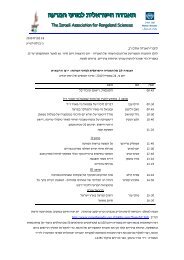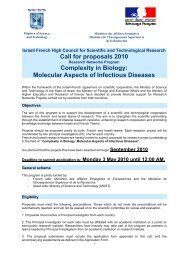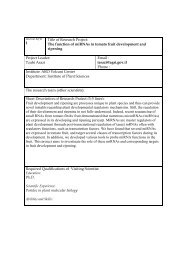Ghanim et al 1998 - Virology .pdf
Ghanim et al 1998 - Virology .pdf
Ghanim et al 1998 - Virology .pdf
You also want an ePaper? Increase the reach of your titles
YUMPU automatically turns print PDFs into web optimized ePapers that Google loves.
VIROLOGY 240, 295–303 (<strong>1998</strong>)ARTICLE NO. VY978937Evidence for Transovari<strong>al</strong> Transmission of Tomato Yellow Leaf Curl Virusby Its Vector, the Whitefly Bemisia tabaciMurad <strong>Ghanim</strong>, Shai Morin, Muhammad Zeidan, and Henryk Czosnek 1Department of Field Crops and Gen<strong>et</strong>ics, and the Otto Warburg Center for Biotechnology in Agriculture, Faculty of Agricultur<strong>al</strong>,Food and Environment<strong>al</strong> Qu<strong>al</strong>ity Sciences, The Hebrew University of Jerus<strong>al</strong>em, Rehovot 76100, P.O. Box 12, IsraelReceived August 12, 1997; r<strong>et</strong>urned to author for revision September 17, 1997; accepted November 9, 1997The whitefly Bemisia tabaci is the only vector of the tomato yellow leaf curl geminivirus (TYLCV). The insect transmits thevirus in a persistent-circulative manner. TYLCV DNA was d<strong>et</strong>ected by polymerase chain reaction and by Southern blothybridization in progeny (eggs, first and second instars, adults) of single viruliferous whiteflies that developed on eggplantor on cotton (two TYLCV nonhost plants). Furthermore, TYLCV DNA was present in the progeny of insects that had acquiredthe virus through the egg. The adult progeny of the viruliferous insects and their own progeny were able to infect tomato testplants, producing typic<strong>al</strong> disease symptoms. Ovaries and maturing eggs of viruliferous insects contained vir<strong>al</strong> DNA, as dideggs laid by viruliferous insects maintained on an artifici<strong>al</strong> di<strong>et</strong>. Eggs laid by nonviruliferous whiteflies on cotton plantspreviously caged with viruliferous insects did not acquire vir<strong>al</strong> DNA from the plant. Hence, TYLCV can be transmitted throughthe egg for at least two generations. In the absence of an available plant host, the whitefly may serve as a reservoir of thevirus b<strong>et</strong>ween growing seasons. © <strong>1998</strong> Academic PressINTRODUCTIONTomato yellow leaf curl virus (TYLCV) is the namegiven to a group of geminiviruses transmitted by thewhitefly Bemisia tabaci (Cohen and Harpaz, 1964;Czosnek <strong>et</strong> <strong>al</strong>., 1988a). TYLCV causes extensive damag<strong>et</strong>o tomato crops in many tropic<strong>al</strong> and subtropic<strong>al</strong>regions worldwide (Czosnek and Laterrot, 1997). Thegenome of TYLCV is either monopartite (Mediterraneanisolates) or bipartite (Thailand isolate) (for reviewsee Pico <strong>et</strong> <strong>al</strong>., 1996; Czosnek and Laterrot, 1997).While the acquisition and transmission of TYLCV by B.tabaci (<strong>al</strong>so denominated Bemisia argentifolii) havebeen studied in some d<strong>et</strong>ail (Cohen and Nitzany, 1966;Zeidan and Czosnek, 1991; Mehta <strong>et</strong> <strong>al</strong>., 1994; Caciagli<strong>et</strong> <strong>al</strong>., 1995; Caciagli and Bosco, 1997; Rubinstein andCzosnek, 1997), the interactions b<strong>et</strong>ween this geminivirus(as well as others) and its insect vector are stillpoorly understood. Similarly to other whitefly-transmittedgeminiviruses (Duffus, 1987), B. tabaci transmitsTYLCV in a persistent-circulative manner (Cohen andNitzany, 1966; Rubinstein and Czosnek, 1997). Thenucleic acid of the virus remains associated with theinsect for its entire adult life; this long-term associationaffects the transmission efficiency, longevity, andfecundity of the insect, features reminiscent of aninsect pathogen (Rubinstein and Czosnek, 1997).Hence, the relationship b<strong>et</strong>ween TYLCV and B. tabaci1 To whom correspondence and reprint requests should be addressed.Fax: 972 8 9468265. E-mail: czosnek@huji.agri.ac.il.seems to be much subtler than the previous assumptions,depicting the passage of the virus in the insectas neutr<strong>al</strong>. In this communication we investigatewh<strong>et</strong>her TYLCV is transmitted by its insect vectorthrough the egg.Transovari<strong>al</strong> transmission of a plant virus by itsinsect vector was first described by Fukushi (1933),who showed that rice dwarf virus was transmitted forsever<strong>al</strong> generations through the egg of the leafhoppervector Nephot<strong>et</strong>tix apic<strong>al</strong>is. The ability of the progenyof viruliferous insects reared on immune plants toinfect susceptible hosts pointed to transovari<strong>al</strong> passageof the virus. Since then, transovari<strong>al</strong> passage ofsever<strong>al</strong> viruses in their leafhopper/planthopper (Grylls,1954; Black, 1953), and aphid (Sylvester, 1969) vectorshas been described (for review see Matthews, 1991).Transovari<strong>al</strong> transmission has been often associatedwith replication of the virus in its vector (Fukushi, 1935;Black, 1950; Duffus, 1963; Miyamoto and Miyamoto,1966) and with del<strong>et</strong>erious effects on the insect host(Sylvester, 1969, 1973; Sylvester and Richardson, 1969).Usu<strong>al</strong>ly, the virus was transmitted to some, but not to<strong>al</strong>l progeny.Until now, <strong>al</strong>l plant viruses that have been shown tobe transmitted to progeny were RNA viruses. Geminiviruseshave not been considered to be transmittedtransovari<strong>al</strong>ly to progeny (Harrison, 1985; Lazarowitz,1992). Using polymerase chain reaction (PCR), Southernblot hybridization, and transmission tests, wepresent evidence that TYLCV can be transmitted to the2950042-6822/98 $25.00Copyright © <strong>1998</strong> by Academic PressAll rights of reproduction in any form reserved.
296 GHANIM ET AL.PCR. Plasmid pTYH19 that contains a cloned copy ofthe TYLCV genome was used as a positive control.Figure 1B shows that the 410-bp TYLCV DNA fragmentthat was amplified from plasmid pTYH19, frominfected tomato, and from viruliferous whiteflies was<strong>al</strong>so amplified from the progeny of the viruliferousfem<strong>al</strong>es (eggs, crawlers, and adults), but not fromthose of nonviruliferous insects. These results suggestthat TYLCV is transmitted to the progeny of viruliferouswhiteflies through the egg.FIG. 1. An<strong>al</strong>ysis of viruliferous whiteflies and their offspring by PCR.(A) Development stages of the whitefly Bemisia tabaci and their duration,under our experiment<strong>al</strong> conditions. The first instar is the crawlerstage; the fourth instar is the pup<strong>al</strong> stage. (B) Amplification of TYLCVDNA from groups of 50 eggs, 20 crawlers and 20 adults, from offspringof viruliferous whiteflies, and from the same number of progeny ofnonviruliferous insects; infected tomato plants and plasmid pTYH19 arepositive controls. The reaction products were submitted to agarose gelelectrophoresis and stained with <strong>et</strong>hidium bromide. Thick arrow, amplifiedTYLCV DNA; thin arrow, primers.progeny of viruliferous insects for at least two generations.RESULTSPCR an<strong>al</strong>ysis of progeny of viruliferous whitefliesWhiteflies develop from an egg, through fournymph<strong>al</strong> instars, into an adult. Figure 1A shows thedevelopment<strong>al</strong> time course under our experiment<strong>al</strong>conditions. The association of TYLCV DNA with developingeggs of viruliferous insects was investigated.Viruliferous whiteflies were caged on eggplants andon cotton plants (about 20 insects per plant) and ontwo TYLCV nonhosts (Cohen and Nitzany, 1966; Al-Musa, 1982). The adults were collected after 5 daysand the eggs were <strong>al</strong>lowed to develop. Samples fromeach development<strong>al</strong> stage (Fig. 1A) were collected atrandom. Tot<strong>al</strong> DNA was extracted from groups of 10viruliferous fem<strong>al</strong>es, 50 of their eggs, 20 crawlers, and20 adult progeny. In par<strong>al</strong>lel, DNA was extracted fromthe same number of nonviruliferous fem<strong>al</strong>es, theireggs, crawlers, and adult progeny and from an infectedtomato leafl<strong>et</strong>. All samples were subjected toThe offspring of a single viruliferous whitefly containTYLCV DNAThe question of wh<strong>et</strong>her TYLCV is present in <strong>al</strong>l progenyof a single viruliferous insect was addressed. Viruliferouswhiteflies were <strong>al</strong>lowed to lay eggs on eggplants(one insect per plant). After 5 days, the insects werecollected and eggs were <strong>al</strong>lowed to develop. In accordancewith the development<strong>al</strong> time sc<strong>al</strong>e of Fig. 1A,eggs, crawlers, pupae, and adults were collected in sucha fashion that <strong>al</strong>l the individu<strong>al</strong>s at a given development<strong>al</strong>stage were progeny of a single insect. DNA extractedfrom each individu<strong>al</strong> was subjected to PCR amplification.Figure 2 shows the 410-bp vir<strong>al</strong> DNA fragment amplifiedfrom 16 of the 23 eggs laid by a single viruliferouswhitefly. Twenty-five of the 30 crawlers issued from anotherviruliferous insect contained vir<strong>al</strong> DNA as did 7 ofthe 13 pupae and 15 of the 16 adults issued from a thirdand a fourth insect. Hence, TYLCV was transmitted tosome, but not to <strong>al</strong>l, progeny of viruliferous whiteflies.This an<strong>al</strong>ysis was extended to the progeny of nineviruliferous whiteflies. Viruliferous insects were <strong>al</strong>lowedto lay eggs on eggplants and on cotton plants (one insectper plant). Eggs, first and second instars, and adultswere collected in such a fashion that <strong>al</strong>l the individu<strong>al</strong>s ata given development<strong>al</strong> stage were progeny of three differentinsects. The progeny from a single insect werekept separated from those of the other insects. DNA fromeach individu<strong>al</strong> was subjected to PCR amplification, asdescribed in the legend to Fig. 2. The results summarizedin Table 1 show that TYLCV DNA was amplifiedfrom some, but not from <strong>al</strong>l progeny. This proportionvaried from insect to insect. TYLCV DNA was present in<strong>al</strong>l of the development<strong>al</strong> stages of the whitefly, from eggto adult. Adult progeny of three addition<strong>al</strong> viruliferousinsects were used to inoculate tomato test plants (seebelow).The second-generation progeny of a singleviruliferous whitefly contain TYLCV DNAThe passage of TYLCV through the egg from the first tothe second generation of viruliferous whiteflies progenywas investigated using the m<strong>et</strong>hods described above.Eggs laid by whiteflies that had acquired TYLCV frominfected tomato were <strong>al</strong>lowed to develop on cotton. The
TRANSMISSION OF TYLCV BY Bemisia tabaci297FIG. 2. PCR amplification of TYLCV DNA in the developing progeny of individu<strong>al</strong> viruliferous whiteflies. All the individu<strong>al</strong>s collected at eachdevelopment<strong>al</strong> stage are offspring of a single whitefly. The reaction products were submitted to agarose gel electrophoresis, blotted, and hybridizedwith the virus DNA probe.adult offspring, 1 to 5 days after emergence, were cagedwith cotton plants, one insect per plant. After 5 days, theinsects were collected and an<strong>al</strong>yzed by PCR for thepresence of TYLCV DNA. Only the progeny of thoseinsects that contained vir<strong>al</strong> DNA were further an<strong>al</strong>yzed.Eggs, first and second instars, and adults were collectedas described above. The progeny from a single insectwere kept separated from those of the other insects.DNA extracted from each individu<strong>al</strong> was subjected toPCR amplification and the products were an<strong>al</strong>yzed asdescribed in the legend to Fig. 2. The results obtainedwith progeny of nine insects are summarized in Table 1.TYLCV DNA was present in <strong>al</strong>l of the development<strong>al</strong>stages of the progeny of whiteflies that have acquired thevirus through the egg. The proportion of individu<strong>al</strong>s containingvir<strong>al</strong> DNA varied from one insect to another andwas similar to that found in the first generation progenyof viruliferous insects. These results showed that TYLCVwas transmitted through the egg for two generations.Adult progeny of three insects, second generation progeny,were used to inoculate tomato test plants.Southern blot an<strong>al</strong>ysis of DNA extracted from groupsof eggs, crawlers, and adults, offspring of the first andthe second generation of viruliferous whiteflies, indi-
298 GHANIM ET AL.TABLE 1Transovari<strong>al</strong> Passage of TYLCV to the Progeny of Viruliferous Whiteflies during Two GenerationsFirst generation progeny: replicate numberSecond generation progeny: replicate number1 2 3 1 2 3Eggs with TYLCV a 16/23 E 15/18 E 15/16 E 15/32 C 7/18 C 4/18 CCrawlers with TYLCV a 4/37 C 14/18 C 7/13 C 14/22 C 9/11 C 12/16 CAdults with TYLCV a 4/27 C 22/30 C 20/24 C 17/18 C 14/16 C 10/18 CInfectivity of adults b 2/10 E 3/20 E 0/20 C 1/15 C 1/16 C 2/18 CNote. Individu<strong>al</strong>s at each development<strong>al</strong> stage in every replicate were progeny from a distinct insect. E,C Insects reared on eggplant or on cotton.a Number of individu<strong>al</strong>s containing TYLCV DNA d<strong>et</strong>ected by PCR/tot<strong>al</strong> number.b Number of individu<strong>al</strong>s able to infect tomato plants in a one insect–one plant test/tot<strong>al</strong> number.cated that they <strong>al</strong>l contained a single d<strong>et</strong>ectable TYLCVDNA species, comigrating with the virus genomic DNAfrom viruliferous whiteflies (Fig. 3).Two generations of viruliferous whitefly offspring cantransmit TYLCV to tomato test plantsAll the adult progeny that developed from eggs laid oneggplants or on cotton during a 5-day period by a singleviruliferous whitefly were tested for their ability to transmitTYLCV to tomato test plants. The whiteflies werecaged with tomato plants (one insect per plant) for 72 h.The presence of vir<strong>al</strong> DNA in the plant was assessed bysquash blot hybridization 3 and 6 weeks thereafter, andthe disease symptoms were monitored throughout thisperiod. The results of inoculation by 10 insects, progenyof a single viruliferous whitefly, are shown in Fig. 4A. Twoof the 10 test plants contained d<strong>et</strong>ectable vir<strong>al</strong> DNA andpresented typic<strong>al</strong> disease symptoms. Hence 2 of 10insects were able to transmit TYLCV.The results obtained with the adult progeny of threeviruliferous whiteflies (summarized in Table 1) showedthat 5 of 50 insects were able to infect tomato plants,producing symptoms similar to those obtained in whitefly-mediatedplant-to-plant inoculation. In similar controlexperiments, insects that fed on infected tomato plantsfor 48 h were able to infect tomato test plants (oneinsect/one plant) with an efficiency of 60 to 100%.All the adult progeny of three whiteflies, second generationoffspring of viruliferous insects, were tested fortheir ability to transmit TYLCV to tomato tests plants, asdescribed above. Four of 49 insects were able to inoculat<strong>et</strong>omato test plants (Table 1). These results showedthat the second generation of insects that acquiredFIG. 3. D<strong>et</strong>ection of TYLCV DNA in Southern blots of eggs, crawlers,and adults, first and second generation progeny of viruliferous insects.DNA was isolated from groups of 50 eggs, 30 crawlers, and 20 adults,subjected to electrophoresis, blotted, and hybridized with the virusspecificDNA probe. The virus genomic DNA is indicated by an arrow(ssDNA).FIG. 4. Transmission of TYLCV to tomato test plants (one insect perplant) by first and second generation offspring of viruliferous insects.(A) Squash blot hybridization of plants (numbered 1–10) following inoculationby first generation progeny of a single viruliferous insect. 0,noninfected plant; INF, tomato plant infected following norm<strong>al</strong> plant-toplanttransmission. (B) Southern blot hybridization of DNA from symptomaticplants infected by first and second generation progeny ofviruliferous whiteflies. 0, tomato plant infected following norm<strong>al</strong> plantto-planttransmission. 1–4, tomato plants infected by progeny of viruliferousinsects. ssDNA, single-stranded TYLCV genomic DNA. dsDNA,double-stranded DNA replicative forms of the virus genomic DNA(upper band, relaxed; lower band, supercoiled).
TRANSMISSION OF TYLCV BY Bemisia tabaci299TYLCV through the egg was able to transmit the virus toplants with efficiency similar to that of the first generation.The Southern blot an<strong>al</strong>ysis shown in Fig. 4B indicatedthat the symptomatic tomato plants inoculated by theprogeny of viruliferous insects and their second generationoffspring contained TYLCV-associated vir<strong>al</strong> DNAforms similar to those present in natur<strong>al</strong>ly infected tomatoes.Developing eggs, instars, and adults could notacquire TYLCV from eggplant or cotton on whichviruliferous whiteflies laid their eggsWe had to exclude the possibility that eggs acquiredTYLCV DNA from the plants on which they developed.During the 5-day oviposition, it is likely that the insectinjected virus while phloem feeding on cotton or eggplant.Although these plants are immune to TYLCV (Cohenand Nitzany, 1966; Al-Musa, 1982), it is still possibl<strong>et</strong>hat the virus was present in und<strong>et</strong>ectable amounts (replicatingor not) in the cells on which the developing eggswere feeding. As a result, the freshly laid eggs may haveacquired the virus from the few inoculated cells via thepedicel, <strong>al</strong>though it pen<strong>et</strong>rates only the leaf epidermis(Pollard, 1955). TYLCV may <strong>al</strong>so have been acquired at <strong>al</strong>ater development<strong>al</strong> stage, by crawlers that are known tofeed on phloem (Pollard, 1955) and by adults.Experiments were conducted (mimicking the experiment<strong>al</strong>conditions described above) to verify that progenyof viruliferous whiteflies, at any development<strong>al</strong> stage,could not acquire TYLCV from the plant on which eggswere laid. One viruliferous insect was caged on each offive eggplants and five cotton plants, using a2cmdiam<strong>et</strong>erleaf cage. After 10 days, the adult as well as <strong>al</strong>l eggsand instars were collected and discarded. Nonviruliferousinsects were caged for 5 days on the same plants(one insect per plant), at the same location, using leafcages. All the crawlers that developed from the eggs andthat were an<strong>al</strong>yzed for the presence of TYLCV DNA byPCR did not contain TYLCV DNA, indicating that eggsand crawlers did not acquired TYLCV DNA from theplants. Five cotton plants and five eggplants were cagedfor 10 days with about 200 viruliferous whiteflies each.The viruliferous insects were discarded, and nonviruliferousones were caged with these plants (200 insectsper plant) for 48 h. These whiteflies were then collectedand caged on six tomato plants for 48 h (50 insects perplant, three plants with insects from eggplants and threewith insects from cotton). Observation of plants for symptomsand hybridization of plant extracts with virus-specificDNA probes showed that none of the tomato plantswas inoculated by these insects. Therefore adult progenyof viruliferous whiteflies could not have acquired(sufficient amounts of) vir<strong>al</strong> DNA from eggplants or cottonplants to inoculate tomato test plants.Eggs laid by viruliferous insects on artifici<strong>al</strong> mediumcontain TYLCV DNAIn order to avoid possible contamination of eggs withTYLCV from the plants, insects were <strong>al</strong>lowed to lay eggson artifici<strong>al</strong> medium. After a 5-day ovoposition period, theeggs were collected individu<strong>al</strong>ly. Tot<strong>al</strong> DNA from eachegg was extracted and subjected to PCR. In one case, 23of the 25 eggs laid by an insect contained TYLCV DNA;in another case, 16 of the 17 eggs laid by another insectcontained vir<strong>al</strong> DNA. Hence, the eggs were laid while<strong>al</strong>ready containing vir<strong>al</strong> DNA.Ovaries and developing eggs of viruliferous insectscontain TYLCV DNAThe experiments described above referred to developingeggs, after oviposition. Viruliferous insects weredissected to verify that the ovaries and the matureeggs in the ovary contained vir<strong>al</strong> DNA. The organswere washed until no vir<strong>al</strong> DNA could be amplified byPCR from the wash. Samples from ovaries and frommature eggs were observed in the scanning electronmicroscope (Figs. 5A and 5B). DNA prepared fromindividu<strong>al</strong> ovaries and from single maturing eggs wassubjected to PCR, and the products were an<strong>al</strong>yzed asdescribed above. The results presented in Fig. 5Cshow that vir<strong>al</strong> DNA was present in the ovaries and inthe mature eggs of viruliferous insects. Washing theeggs with miner<strong>al</strong> oil to avoid possible contaminationwith hemolymph did not eliminate the vir<strong>al</strong> DNA.DISCUSSIONIn this study, we have examined wh<strong>et</strong>her TYLCV canbe transmitted to the progeny of viruliferous whitefliesthrough the egg. The ration<strong>al</strong>e of this question wasbased on observations regarding the surviv<strong>al</strong> of the virusb<strong>et</strong>ween growing seasons of tomato: (1) The virus is nottransmitted through seeds of infected plants; (2) there isno obvious <strong>al</strong>ternative host to tomato that has beenshown to be the likely reservoir of the virus b<strong>et</strong>weenseasons; (3) infection of tomatoes starts <strong>al</strong>most immediatelyafter planting even when the insect population isnot at its peak (Cohen <strong>et</strong> <strong>al</strong>., 1988). Therefore, we havepostulated that the whitefly serves as a source for thevirus, which is passed from generation to generationthrough the egg.Besides the molecular biology techniques that werenot available at that time, we have followed m<strong>et</strong>hodologiesused to demonstrate transovari<strong>al</strong> passage of anumber of plant viruses by their leafhopper, planthopper,or aphid vector (Black, 1950, 1953; Grylls, 1954;Duffus, 1963; Sylvester, 1969; Sylvester and Richardson,1969, 1970). We have shown here by PCR amplification,by Southern blot hybridization, and by transmissiontests that indeed TYLCV can be found in
300 GHANIM ET AL.FIG. 5. Presence of TYLCV in ovaries and in developing eggs of viruliferous insects. (A and B) Ovaries were dissected from viruliferous whitefliesand observed in the scanning electron microscope. (A) Ovaries with immature eggs. (B) Ovaries with a mature egg. (C) PCR amplification of TYLCVDNA from two individu<strong>al</strong> ovaries and from a single egg. The products were an<strong>al</strong>yzed by agarose gel electrophoresis, stained with <strong>et</strong>hidium bromide(top), blotted, and hybridized with a virus-specific probe (bottom). Plasmid pTYH19 was a positive control.progeny of a single viruliferous insect for at least twogenerations, demonstrating that TYLCV can be transmittedthrough the egg.In experiments aimed at d<strong>et</strong>ecting transovari<strong>al</strong> transmission,it is essenti<strong>al</strong> to eliminate the possibility that theprogeny acquire the virus from plants on which they arereared. Inoculation and transmission tests using whiteflieshave shown that cotton and eggplant are TYLCVnonhosts (Cohen and Nitzany, 1966; Al-Musa, 1982). Regardless,we had to exclude the possibility that eggs,crawlers, or adult whiteflies acquired the virus from theeggplant and cotton on which viruliferous insects fedduring oviposition. Ide<strong>al</strong>ly, the eggs laid by viruliferouswhiteflies and by their offspring should have been transferredimmediately to new plants to avoid possible contamination.Unfortunately whitefly eggs did not developafter transplantation on eggplant, cotton, or tomato.Therefore, we tested the possibility that eggs, crawlers,or adults could acquire (and later transmit) TYLCV fromthe eggplant and cotton plant on which viruliferous insectshad fed. Eggplants and cotton plants on which asingle viruliferous insect had laid its eggs did not containTYLCV DNA in amounts d<strong>et</strong>ectable by PCR. Egg andcrawler progeny of nonviruliferous insects were unabl<strong>et</strong>o acquire virus from such plants. Moreover, nonviruliferousadults were unable to acquire (or later transmit)the virus from cotton and eggplants previously cagedwith a large number of viruliferous insects. We have triedto use artifici<strong>al</strong> media to achieve development of theprogeny of viruliferous insects as an <strong>al</strong>ternative to nonhostplants. We found that eggs laid and maintained onartifici<strong>al</strong> di<strong>et</strong> <strong>al</strong>so contained TYLCV DNA. On the di<strong>et</strong> weused, eggs developed until the second instar stage only,preventing us from assessing the ability of the adultinsect to transmit the virus to tomato test plants. Themost successful di<strong>et</strong> described <strong>al</strong>lowed development tofourth instar only; compl<strong>et</strong>e development to the adultstage has not been achieved (Jancovich <strong>et</strong> <strong>al</strong>., 1997).The way in which TYLCV pen<strong>et</strong>rates the whitefly reproductivesystem is unknown. TYLCV is transmitted bythe whitefly B. tabaci in a persistent-circulative manner.Similarly to other geminiviruses, TYLCV is acquired whilefeeding and passes through the <strong>al</strong>imentary can<strong>al</strong> and themidgut, enters the hemolymph, and fin<strong>al</strong>ly reaches thes<strong>al</strong>ivary glands from which it is transmitted to the plant(Harris <strong>et</strong> <strong>al</strong>., 1995). Dissection and an<strong>al</strong>ysis of the reproductivesystem of viruliferous whiteflies showed thatboth the ovaries and the maturing eggs contained TYLCVDNA. Observations on the maturation process of eggs inthe ovaries suggest a possible role of insect endosymbiontsin virus transovari<strong>al</strong> transmission. Whitefly endosymbionts(as well as endosymbionts from leafhoppers,aphids, and me<strong>al</strong>ybugs) are passed from generation togeneration only via the egg. Endosymbionts are incorporatedduring egg maturation, pen<strong>et</strong>rating via an aperturein the membrane (Costa <strong>et</strong> <strong>al</strong>., 1996a). It is possible, butnot proven, that TYLCV pen<strong>et</strong>rates the egg at this stage.Indeed, electron microscope observation indicated thatrice dwarf virus enters the egg on the membrane surfaceof one type of endosymbiont of the myc<strong>et</strong>ome of theleafhopper vector Nephot<strong>et</strong>tix cincticeps (Nasu, 1965). Inwhiteflies, unidentified virus-like particles have been observedabutting the nuclear membrane in ovarian tissueand in myc<strong>et</strong>ocyte cells (Costa <strong>et</strong> <strong>al</strong>., 1996b), suggesting
TRANSMISSION OF TYLCV BY Bemisia tabaci301that virus may invade B. tabaci eggs via the endosymbiont.Our recent findings demonstrating that TYLCV capsidprotein contains a function<strong>al</strong> nuclear loc<strong>al</strong>ization sign<strong>al</strong>that <strong>al</strong>lows the protein to pen<strong>et</strong>rate insect cell nuclei(Kunik <strong>et</strong> <strong>al</strong>., 1997) may be relevant to the mechanism bywhich the virus finds its way into maturating whiteflyeggs.Invasion of the whitefly reproduction system andtransmission of TYLCV to progeny is one of the manyfac<strong>et</strong>s of the interaction of the virus with its vector.Following acquisition after emergence, the amount ofvir<strong>al</strong> DNA remained approximately constant during the30- to 40-day-long adult life of the insect, whereas thecapsid protein vanished after about 10 days and th<strong>et</strong>ransmission efficiency decreased from 100 to 10%(Rubinstein and Czosnek, 1997). These findings implythat most of the virus, considered as an infectiousentity, leaves the transmission pathway progressively.A decrease of approximately 20% in the life expectancyof the insect and a reduction of 50% in thenumber of eggs laid accompanied the long-time associationof TYLCV with the whitefly (Rubinstein andCzosnek, 1997). The decrease in fertility may be aresult of TYLCV invading the insect reproduction tissuesand pen<strong>et</strong>rating (and perhaps aborting part of)the maturing eggs. Of the plant viruses transmittedthrough the egg, some invade many insect tissues andorgans (Sylvester and Richardson, 1970), replicate intheir insect vector (Sylvester, 1969; Sylvester and Richardson,1969), and cause a decrease in the longevityof their insect host (Sylvester, 1973).In our study, we have used mainly PCR technologyto d<strong>et</strong>ect the presence of TYLCV DNA in offspring ofviruliferous whiteflies. The large proportion of individu<strong>al</strong>sthat contained TYLCV DNA contrasted with thesm<strong>al</strong>l proportion of insects that were able to transmitthe virus in biologic<strong>al</strong> tests (Table 1). Hence, most ofthe insects contained virus below the amount neededto infect tomato plants. In each generation, up to 20%of the offspring were able to infect tomato plants,compared with 60 to 100% of the insects that acquiredthe virus from infected plants. These figures providean estimation of the rate at which inoculativity of aninsect population diminishes from generation to generation,in the absence of an extern<strong>al</strong> virus source andprovided that there is no input of exogenous viruliferousinsects.The finding that TYLCV can be transmitted from insectto insect through the egg is of importance in the epidemiologyof the TYLCV disease. In the absence of a hostplant, the whitefly may constitute the major host of thevirus b<strong>et</strong>ween growing seasons and may serve as areservoir immediately available when tomato plants areplanted in the open field.MATERIALS AND METHODSMaintenance of virus cultures, whiteflies, and plantsCultures of the Israeli isolate of TYLCV (Navot <strong>et</strong> <strong>al</strong>.,1991) were maintained in tomato plants (Lycopersiconesculentum, cv. Daniella). B. tabaci of the B biotype(Cohen, 1993) were reared on cotton plants (Gossypiumhirsutum, cv. Ak<strong>al</strong>a) grown in insect-proof wooden cagesat 24–27°C, as previously described (Zeidan and Czosnek,1991).Acquisition of TYLCV by adult insects, oviposition,and transmission of TYLCV by adult progenyAll experiments were conducted in insect-proofwooden cages kept at 24–27°C in an insect-proof growthchamber; leaf cages were used when necessary. TYLCVwas acquired by whiteflies, 5–8 days after emergence,after being caged for 48 h with the youngest true leaf ofinfected tomato plants. The viruliferous insects werecaged with either cotton plants (G. hirsutum, cv. Ak<strong>al</strong>a) oreggplants (Solanum melongena, cv. Hishtil) at their twoto four leaf stage for a 5-day oviposition period. Inoculationof TYLCV by adult progeny of viruliferous insectswas achieved by caging a single insect with the youngesttrue leaf of a tomato seedling at its two to four leafstage.Sampling whiteflies at different development stagesViruliferous whiteflies were caged with eggplants andwith cotton plants (one insect per plant, 20 plants). Theinsects were collected individu<strong>al</strong>ly after 5 days. All theeggs laid by a single whitefly were collected from someof the plants, while the eggs were <strong>al</strong>lowed to develop onthe remaining plants. In accordance with the development<strong>al</strong>time sc<strong>al</strong>e of Fig. 1A, the crawlers were collectedfrom a second group of plants, the pupae from a thirdgroup, and the adults from a fourth group of plants. In thismanner, <strong>al</strong>l the individu<strong>al</strong>s collected at a given development<strong>al</strong>stage from a distinct plant were progeny of asingle viruliferous whitefly.Preparation of insect DNA and amplification of TYLCVDNA using the PCRIndividu<strong>al</strong> eggs, instars, or adults were homogenizedin 30, 40, or 100 l (respectively) of a solution comprising100 g/ml proteinase K, 0.45% Triton X-100, 0.45% Tween20,and1MTris–HCl, pH 8.0. The mixture was incubatedat 55°C for 1 h followed by 10 min at 100°C and 5 min at0°C. The mixture was cleared by a 5-min centrifugationat 10,000 g. The supernatant (2 l) was used for the PCR(50 l). It was som<strong>et</strong>imes necessary to dilute the supernatant(1/10 to 1/1000) to g<strong>et</strong> efficient amplification.A 410-bp TYLCV DNA fragment was amplified usingtwo primers deduced from the nucleotide (nt) sequenceof the genome of TYLCV from Israel (Navot <strong>et</strong> <strong>al</strong>., 1991):
302 GHANIM ET AL.V61 (nt 61–80, vir<strong>al</strong> strand, 5ATACTTGGACACCTAAT-GGC3) and C473 (nt 473–457, complementary strand,5AGTCACGGGCCCTTACA3). Oligonucleotides werepurchased from Biotechnology Gener<strong>al</strong> (Rehovot, Israel).The cycling protocol (using a Techne PHC-2 thermocycler)was as follows: initi<strong>al</strong> denaturation for 3 min at95°C, anne<strong>al</strong>ing of primers for 1 min at 45°C, addition of1 unit of TaqI polymerase, extension for 2 min at 72°C,and denaturation for 1 min at 94°C; subsequent cycleswere: 1 min at 45°C, 2 min at 72°C, and 1 min at 94°C;after 30 cycles, the reaction was terminated by a 10 minincubation at 72°C (Navot <strong>et</strong> <strong>al</strong>., 1992). The PCR productswere subjected to electrophoresis in a 1% agarose geland were photographed. The amplified virus DNA wasidentified after blotting and hybridization with radiolabeledplasmid pTYH19 containing a full-length copy ofthe TYLCV genome (Navot <strong>et</strong> <strong>al</strong>., 1991). Autoradiographywasfor1to5h.D<strong>et</strong>ection of TYLCV DNA in plants and in insects bysquash blot and Southern blot hybridizationSquashes of tomato leaves were prepared and hybridizedwith a radiolabeled DNA probe as described previously(Navot <strong>et</strong> <strong>al</strong>., 1989). Tot<strong>al</strong> DNA extracted from tomatoplants and from insects (egg, instar, and adult) was hybridizedwith radiolabeled plasmid pTYH19 as described (Czosnek<strong>et</strong> <strong>al</strong>., 1988b; Zeidan and Czosnek, 1991).Dissection of ovaries and maturing eggs of B. tabaciand observation in the scanning electron microscopeInsects were kept on the microscope cylindric<strong>al</strong> mountusing double-sided adhesive tape. The abdomen wasseparated from the thorax and pressing the tip of theabdomen expelled its content. The intern<strong>al</strong> organs werewashed sever<strong>al</strong> times with water using a Pasteur pip<strong>et</strong>tewith a narrow tip, and the ovaries were separated fromthe other organs. For PCR an<strong>al</strong>ysis, DNA was extractedas described above. For microscope observation, th<strong>et</strong>issues were processed essenti<strong>al</strong>ly as described by Nation(1983), omitting the treatment with hexam<strong>et</strong>hyldisilazane.Ovaries were fixed by immersing the tissues in0.2% glutar<strong>al</strong>dehyde, 4% paraform<strong>al</strong>dehyde in PBS for 5min. The tissues were then flushed two to three timeswith sterile distilled water and <strong>al</strong>lowed to air dry. Thesamples were observed in a JOEL 5410 LV scanningelectron microscope at low vacuum.Oviposition on artifici<strong>al</strong> mediumViruliferous insects were placed in a 5-ml glass vi<strong>al</strong>(one insect per vi<strong>al</strong>). The vi<strong>al</strong> was covered with a layer ofKimwipes held in place with a layer of str<strong>et</strong>ched Parafilmmembrane (the paper <strong>al</strong>lowed the eggs to stick). About0.5 ml LB medium containing 15% sucrose was depositedon the membrane and covered with a second layerof str<strong>et</strong>ched Parafilm membrane.ACKNOWLEDGMENTSThis work was supported by Grant 95-168 from The US-Israel Bination<strong>al</strong>Science Foundation. M.Z. was recipient of The Golda Meir FellowshipFund.REFERENCESAl-Musa, A. (1982). Incidence, economic importance, and control oftomato yellow leaf curl in Jordan. Plant Dis. 66, 561–563.Black, L. M. (1950). A plant virus that multiplies in its insect vector.Nature 166, 852–853.Black, L. M. (1953). Occasion<strong>al</strong> transmission of some plant virusesthrough the eggs of their insect vectors. Phytopathology 43, 9–10.Caciagli, P., Bosco, D., and Al-Bitar, L. (1995). Relationships of theSardinian isolate of tomato yellow leaf curl geminivirus with itswhitefly vector Bemisia tabaci Gen. Eur. J. Plant Pathol. 101, 163–170.Caciagli, P., and Bosco, D. (1997). Quantitation over time of tomatoyellow leaf curl geminivirus DNA in its whitefly vector. Phytopathology87, 610–613.Cohen, S., and Harpaz, I. (1964). Periodic, rather than continu<strong>al</strong>, acquisitionof a new tomato virus by its vector, the tobacco whitefly(Bemisia tabaci Gennadius). Ent. Exp. Appl. 7, 155–166.Cohen, S., and Nitzany, F. E. (1966). Transmission and host range of th<strong>et</strong>omato yellow leaf curl virus. Phytopathology 56, 1127–1131.Cohen, S., Kern, J., Harpaz, I., and Ben-Joseph, R. (1988). Epidemiologic<strong>al</strong>studies of the tomato yellow leaf curl virus (TYLCV) in the JordanV<strong>al</strong>ley, Israel. Phytoparasitica 16, 259–270.Cohen, S. (1993). Swe<strong>et</strong> potato whitefly biotypes and their connectionwith squash silver leaf. Phytoparasitica 21, 174.Costa, H. S., Toscano, N. C., and Henneberry, T. J. (1996a). Myc<strong>et</strong>ocyteinclusion in the oocytes of Bemisia argentifollii (Homoptera: Aleyrodidae).Ann. Entomol. Soc. Am. 89, 694–699.Costa, H. S., Westcot, D. M., Ullman, D. E., Rodell, R. C., Brown, J. K., andJohnson, M. W. (1996b). Virus-like particles in the myc<strong>et</strong>ocyte of theswe<strong>et</strong>potato whitefly, Bemisia tabaci (Homoptera, Aleyrodidae). J. Invert.Pathol. 67, 183–186.Czosnek, H., Ber, R., Antignus, Y., Cohen, S., Navot, N., and Zamir, D.(1988a). Isolation of the tomato yellow leaf curl virus—A geminivirus.Phytopathology 78, 508–512.Czosnek, H., Ber, R., Navot, N., Zamir, D., Antignus, Y., and Cohen, S.(1988b). D<strong>et</strong>ection of tomato yellow leaf curl virus in lysates of plantsand insects by hybridization with a vir<strong>al</strong> DNA probe. Plant Dis. 72,949–951.Czosnek, H., and Laterrot, H. (1997). A worldwide survey of tomatoyellow leaf curl viruses. Arch. Virol. 142, 1391–1406.Duffus, J. E. (1963). Possible multiplication in the aphid vector ofsowthistle yellow vein virus, a virus with an extremely long insectlatent period. <strong>Virology</strong> 21, 194–202.Duffus, J. E. (1987). Whitefly transmission of plant viruses. In ‘‘CurrentTopics in Vector Research’’ (K. F. Harris, Ed.), Vol. 4, pp. 73–91.Springer-Verlag, Berlin.Fukushi, T. (1933). Transmission of the virus through the eggs of aninsect vector. Proc. Imp. Acad. (Tokyo) 9, 457–460.Fukushi, T. (1935). Multiplication of virus in its vector. Proc. Imp. Acad.(Tokyo) 11, 801–303.Grylls, N. E. (1954). Rugose leaf curl—A new virus disease transovari<strong>al</strong>lytransmitted by the leafhopper Austroag<strong>al</strong>lia torrida. Austr<strong>al</strong>ian.J. Biol. Sci. 7, 47–58.Harris, K. F., Pesic-Van Esbroeck, Z., and Duffus, J. E. (1995). Anatomy ofa virus vector. In ‘‘Bemisia 1995: Taxonomy, Biology, Damage, Controland Management’’ (D. Gerling and R. Mayer, Eds.), pp. 289–318.Intercept, Buckinghamshire, UK.Harrison, B. D. (1985). Advances in geminivirus research. Annu. Rev.Phytopathol. 23, 55–82.Jancovich, J. K., Davidson, E. W., Lavine, M., and Hendrix, D. L. (1997).Feeding chamber and di<strong>et</strong> for culture of nymph<strong>al</strong> Bemisia argentifolii(Homoptera: Aleyrodidae). J. Econom. Entomol. 90, 628–633.
TRANSMISSION OF TYLCV BY Bemisia tabaci303Kunik, T., P<strong>al</strong>anichelvam, K., Czosnek, H., Citovsky, V., and Gafni, Y.(1997). Nuclear import of a geminivirus capsid protein in plant andinsect cells: Implications for the vir<strong>al</strong> nuclear entry. Plant J. [In press.]Lazarowitz, S. G. (1992). Geminiviruses: Genome structure and genefunction. Crit. Rev. Plant Sci. 11, 32–349.Matthews, R. E. F. (1991). Relationships b<strong>et</strong>ween plant viruses andinvertebrates. In ‘‘Plant <strong>Virology</strong>,’’ pp. 520–561. Academic Press, NY.Mehta, P., Wyman, J. A., Nakhla, M. K., and Maxwell, D. P. (1994).Transmission of tomato yellow leaf curl geminivirus by Bemisiatabaci (Homoptera: Aleyrodidae). J. Econom. Entomol. 87, 1291–1297.Miyamoto, S., and Miyamoto, Y. (1966). Notes on aphid-transmission ofpotato leafroll virus. Sci. Rept. Hyogo Univ. Agr. 7, 51–56.Nasu, S. (1965). Electron microscopic studies on transovari<strong>al</strong> passageof rice dwarf virus. Jpn. J. Appl. Entomol. Zool. 9, 225–237.Nation, J. L. (1983). A new m<strong>et</strong>hod using hexam<strong>et</strong>hyldisilazane forpreparation of soft insect tissues for scanning electron microscope.Stain Technology 58, 347–351.Navot, N., Ber, R., and Czosnek, H. (1989). Rapid d<strong>et</strong>ection of tomatoyellow leaf curl virus in squashes of plant and insect vectors. Phytopathology79, 562–568.Navot, N., Pichersky, E., Zeidan, M., Zamir, D., and Czosnek, H. (1991).Tomato yellow leaf curl virus: A whitefly-transmitted geminivirus witha single genomic component. <strong>Virology</strong> 185, 151–161.Navot, N., Zeidan, M., Pichersky, E., Zamir, D., and Czosnek, H. (1992).Use of the polymerase reaction to amplify tomato yellow leaf curlvirus DNA from infected plants and viruliferous whiteflies. Phytopathology82, 1199–1202.Pico, B., Diez, M. J., and Nuez, F. (1996). Vir<strong>al</strong> diseases causing thegreatest economic losses to the tomato crop. II. The tomato yellowleaf curl virus—A review. Sci. Hort. 67, 151–196.Pollard, D. G. (1955). Feeding habits of the cotton whitefly. Ann. Appl.Biol. 43, 664–671.Rubinstein, G., and Czosnek, H. (1997). Long-term association of tomatoyellow leaf curl virus (TYLCV) with its whitefly vector Bemisia tabaci:Effect on the insect transmission capacity, longevity and fecundity.J. Gen. Virol. 78, 2683–2689.Sylvester, E. S. (1969). Evidence of transovari<strong>al</strong> passage of thesowthistle yellow vein virus in the aphid Hyperomyzus lactucae.<strong>Virology</strong> 38, 440–446.Sylvester, E. S., and Richardson, J. (1969). Addition<strong>al</strong> evidence of multiplicationof the sowthistle yellow vein virus in an aphid vector—Seri<strong>al</strong> passage. <strong>Virology</strong> 37, 26–31.Sylvester, E. S., and Richardson, J. (1970). Infection of Hyperomyzuslactucae by sowthistle yellow vein virus. <strong>Virology</strong> 42, 1023–1042.Sylvester, E. S. (1973). Reduction of excr<strong>et</strong>ion, reproduction, and surviv<strong>al</strong>in Hyperomyzus lactucae fed on plants infected with isolates ofsowthistle yellow vein virus. <strong>Virology</strong> 56, 632–635.Zeidan, M., and Czosnek, H. (1991). Acquisition of tomato yellow leafcurl virus by the whitefly Bemisia tabaci. J. Gen. Virol. 72, 2607–2614.
















